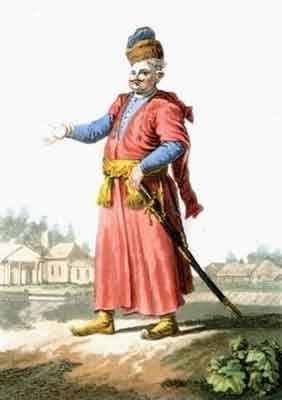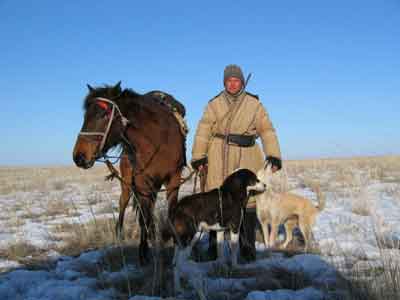|
|
 Sarmatia Europæa" separated from "Sarmatia Asiatica" by the Tanais (the River Don), based on Greek literary sources, in a map printed in London, ca 1770. When one crosses the Tanais, one is no longer in Scythia; the first region on crossing is that of the , viewing votive offerings near the Athenian Acropolis in the 2nd century A.D. (Description of Greece 1.21.5-6), found among them a Sauromatic breastplate. On seeing this a man will say that no less than Greeks are foreigners skilled in the arts: for the Sauromatae have no iron, neither mined by themselves nor yet imported. They have, in fact, no dealings at all with the foreigners around them. To meet this deficiency they have contrived inventions. In place of iron they use bone for their spear-blades, and cornel-wood for their bows and arrows, with bone points for the arrows. They throw a lasso round any enemy they meet, and then turning round their horses upset the enemy caught in the lasso. Their breastplates they make in the following fashion. Each man keeps many mares, since the land is not divided into private allotments, nor does it bear any thing except wild trees, as the people are nomads. These mares they not only use for war, but also sacrifice them to the local gods and eat them for food. Their hoofs they collect, clean, split, and make from them as it were python scales. Whoever has never seen a python must at least have seen a pine-cone still green. He will not be mistaken if he liken the product from the hoof to the segments that are seen on the pine-cone. These pieces they bore and stitch together with the sinews of horses and oxen, and then use them as breastplates that are as handsome and strong as those of the Greeks. For they can withstand blows of missiles and those struck in close combat. Pausanias' description is well borne out in a relief from Tanais, illustation top right. These facts are not necessarily incompatible with Tacitus, as the Sarmatians on the west might have kept their iron to themselves, it having been a scarce commodity on the plains. If true, this circumstance argues for a lack of central government or even for bad communication (as opposed to the Persians). Pontic inscriptions The greater part of the barbarian names occurring in the inscriptions of Olbia, Tanais and Panticapaeum are supposed to be Sarmatian, and as they have been well explained from the Iranian language now spoken by the Ossetians of the Caucasus (the Ossetic language), these are supposed to be the modern representatives of the Sarmatians and can be shown to have a direct connection with the Alans, one of their tribes. Ptolemy By the 3rd century BC, the Sarmatian name appears to have supplanted the Scythian in the plains of what is now south Ukraine. The geographer, Ptolemy, reports them at what must be their maximum extent, divided into adjoining European and central Asian sections. Considering the overlap of tribal names between the Scythians and the Sarmatians, no new displacements probably took place. The people were the same Indo-Europeans they used to be, but now under yet another name. Ammianus Marcellinus Sarmatians were still a force the Romans had to reckon with in the late 4th century A.D. Ammianus Marcellinus (29.6.13-14) describes a severe defeat, which Sarmatian raiders inflicted upon Roman forces in the province of Valeria in Pannonia in late 374 A.D. The Sarmatians almost annihilated both a legion recruited from Moesia and one from Pannonia, which had been sent to intercept a party of Sarmatians who had been pursuing a senior Roman officer named Aequitius deep into Roman territory. The two legions failed to coordinate and their quarrelling allowed the Sarmatians to catch them unprepared and deal a stunning blow. End The Sarmatians remained dominant until the Gothic ascendance in the Black Sea area and then disappeared at the Hunnish destruction of the Gothic empire and subsequent invasion of central Europe. From bases in Hungary the Huns ruled the entire former Sarmatian territory. Their various constituents enjoyed a floruit under Hunnish rule, fought for the Huns against a combination of Romans and Germanics, and went their own ways after the Battle of Chalons (a stand-off), the death of Attila and the disappearance of the Chuvash ruling elements west of the Volga. They played a significant part in the rise of early Russia. Sarmatian tribes Below is a list of tribes considered by some ancient writer respected as an authority to be among the people called Sarmatian, or to be in territory considered Sarmatian. Note that the political and ethnic affiliations of the Sarmatians as well as their territory varied somewhat over the centuries. Some of the ethnic groups or tribal entities listed by one author may be considered part of some other group by another. Moreover the Sarmatians were not always everywhere distinct from other groups, most notably the Scythian, from whom some think they came. On the whole however the ancients recognized a separate unity, whether of political affiliations, language, or both, called the Sarmatian. We do not know its languages for certain. From its location, it must have included some form of Balto-Slavic, but Iranians were part of the range as well. Some of the names are like names in other regions. They are not necessarily speakers of languages in those regions, as they may have assimilated, or the name may refer to a linguistically related people.
Archaeology and ethnology There is an archaeology of the Alans, which has been labeled the archaeology of the Sarmatians. In 1947 B.N. Grakov defined a culture apparent in late kurgan graves, sometimes reusing part of much older kurgans. It is a nomadic steppe culture ranging from the Black Sea to beyond the Volga, and is especially evident at two of the major sites at Kardaielova and Chernaya in the trans-Uralic steppe. The date of the culture: from the 7th century BC to the 4th century AD, and the location, is right for the Sarmatians. Accordingly Grakov defined four phases:
The Sarmatians of Ptolemy fall into the Middle Sarmatian period. However, Grakov’s Sarmatian does not extend at all into the Balto-Slavic range, where the two elements have their own archaeologies descending to the Balts and the Slavs. One might therefore conclude that the Alans were the dominant element of the confederacy. Archaeology springs a few surprises on students of the Roman empire. In the Roman authors the existence of the Chinese is little suspected. Many earlier scholars concluded that the Chinese were unknown to the Romans. And yet, they appear in Ptolemy as the Seres, to the east of the Scyths, and Ptolemy was certainly a favorite text of late Roman students and scholars. Ptolemy seems to have been familiar with most of the far east as well as central Asia and the central Asian subcontinent. Perhaps the peoples there were too remote for serious consideration; however, they were not at all remote to the Alans. Alanic women of the Middle and Late Sarmatian Periods wore pendant hand mirrors imitating Chinese mirrors of the same period. They were ornate bronze disks silvered or tinned on one side. The decorative motivs are reminiscent of Scythian art with similarities to both Chinese and Mycenaean Greek themes. Similar mirrors are known from Japan. Alanic women decorated their clothing and shoes with beads of glass and precious stones embroidered into the cloth, many of which by analysis have been traced to a Chinese origin. And yet the remains of the Alans indicate they were entirely Europoid in appearance. One might presume a trade intermediary, which kept the Alans from intermarriage with the Chinese for the times. Authors such as Jordanes (a Gothicised Alan) and Ammianus Marcellinus lead us to believe that the Huns burst in upon the Ostrogoths completely by surprise from totally unknown regions to the east containing horrible monsters and fearsome innumerable enemies on horseback. This view must be old wives’tales from unfortunate Gothic refugee dependents. In fact Ptolemy mentions the Chuni as one of the peoples in the Sarmatian domain. Scholars did not know what to make of this, or of the Serbi, who were located on the Volga. The consensus now is that the Serbi were early Serbs, who were nomadic, and the Chuni were Huns. The latter were not only known to the Sarmatians and therefore to the Goths, but were subordinate to each in turn. Already anchored in the west in east Europe, the Huns were located to the north of the Alans and extended east to the borders of the Han Dynasty. These Huns were quite peaceful trading partners of the Alans. Their archaeology and mode of life is nearly indistinguishable from that of the Alans. The various peoples of the extensive eastern plains did own distinctive bronze kettles. Also, the graves of the people of central Asia, inluding those of the Huns, include remains that many believe are of mixed features, just as are the peoples of central Asia today. Whatever happened in the east to bring warriors from there upon the Alans did not introduce a new people to the steppes or to Europe. As far as the Sarmatians are concerned, the Hunnic augment from the east only worked an ethnic reversal of dominance. Some Alans chose to flee to the Romans and others to fight for the Huns. The former disappeared into Europe long ago, while the latter remain in the Caucasus region. The Polish idea of "Sarmatians"
Polish Szlachcic. Painting by Jan Piotr Norblin.Main article: Sarmatism "Sarmatism" (Polish: sarmatyzm) was the name of the lifestyle and culture of the szlachta (gentry) in the Polish-Lithuanian Commonwealth from at least the 16th century to the end of the 18th century. The name and the culture were reflected in contemporary Polish literature, like that of Jan Chryzostom Pasek's Memoirs or poems of Wacław Potocki. Szlachta wore long coats trimmed with fur (żupany) and thigh-high boots, and bore sabres (szable), the "Sarmatian" costume they liked to be painted in, proclaiming their link to their presumed legendary ancestors, the historic Sarmatians, and the cultural ideology that sustained their connections with a nobility on horseback, equals among themselves (the "Golden Freedom") and invincible to foreigners (according to Simon Schama, Landscape and Memory 1995, p. 38). Sarmatia (Polish: Sarmacja) was also the unofficial, semi-legendary and poetic name of the Commonwealth, which became fashionable in the 17th century, designating qualities associated with the literate citizenry of the vast Polish-Lithuanian Commonwealth. In contemporary Poland, "Sarmatian" (sarmacki) is a form of ironic self-identification, and is sometimes used as a synonym for the Polish national character. Recent research
Kazakh shepherd south of Aqtöbe, western Kazakhstan In a recent excavation of Sarmatian sites by Dr. Jeannine Davis-Kimball, a tomb was found wherein female warriors were buried, thus lending some credence to the myths about the Amazons. Following the excavation in 2003 by Dr. Davis-Kimball, she and Dr. Joachim Burger compared the genetic evidence from the site with the nomadic Kazakhs, and have found a striking genetic link – verified later by the University of Cambridge [1] – and lending credence to the long-held thesis that the ancient Turkic people who expanded into this region neither exterminated nor completely drove out the original Iranian inhabitants, but indeed assimilated a significant number of them. A recent paper on the study of glass beads found in Sarmatian graves suggests wide cultural and trade links [2]. Trivia "Sarmatian Knights" were prominently featured in the 2004 film King Arthur. References
Links Retrieved from "http://en.wikipedia.org "
 |
|
||||||||||||||

